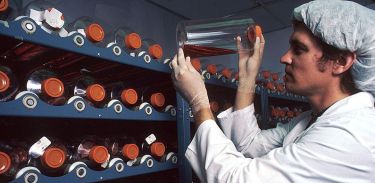Patents

A patent can be defined as a time-limited,
commercial and state-sanctioned exclusive right to technical inventions
of an assured minimum quality The invention, which can be a procedure,
device, use, or product should be able to be applied industrially
and to be repeated by other researchers. Such a technical invention
can concern computer program-related inventions as well as microbiological
procedures and products. For more information, see the page on patents
on genetic-technical inventions. The technical demand does not
exclude, for example, toys or inventions within the agricultural
sector from items able to be patented. In recent years there has
been a lively discussion regarding patents on methods and processes,
which have made inroads in countries such as the US. In Europe,
there exists a fundamental requirement for a "technical effect"
from a patentable invention.
A patent is obtained through an application procedure consisting of a rather careful pre-investigation into whether the invention in question fills the legal requirements of a patentable invention. Obtaining a patent is a fairly costly procedure, especially as one must as a rule obtain patents in many countries for the protection to be effective. A patent is sought and decided on in each individual country. In many European countries, a patent can also be applied for according to the European Patent Convention of 1973 (EPC, last updated 2005). Anyone wishing for a patent also in non-european countries may instead seek patent according to the Patent Cooperation Treaty (PCT), which is adminestered by the World Intellectual Property Organizations (WIPO). PCT has recently been revised (see the "regulations").
Community patent
For decades in Europe, there has been an ongoing negotiation regarding a proposal for a patent applicable to the European Community - a Community Patent - which is to encompass the entire EU with a unitary right. Trough the so called Lisbon Strategy it is urgent that a common patent system in Europe is realised. Even though European patents can be granted today, each Member State still require that in order for it to be legally valid in their territory the European Patent is translated into its official language. Translation costs thereby make patenting in Europe significantly more expensive than in the US or Japan. This difficulty is increased by the need to work in different european national court systems in case of dispute. Also this has to be solved. See also the Communication from the Commission to the European Parliament and the Council - Enhancing the patent system in Europe.
International patent cooperation
International cooperation is regulated through Paris Convention for the Protection of Industrial Property, which is administered by WIPO. Besides the important Patent Cooperation Treaty (PCT) there is also a Patent Law Treaty (PLT), which is a treaty providing common, or minimum, standards for many of the procedures involved in making a patent application. many countries are also part of the 'TRIPs Agreement' - the Agreement on Trade-Related Aspects of Intellectual Property Rights. This is managed by the WTO (World Trade Organisation, which replaced the General Agreement on Tariffs and Trade, or GATT, in 1995). It places important and harmonizing demands on member countries' patent rights. Public health issues to which the TRIPs agreement has relevance has been regulated by the Doha declaration.
The authorities
Authorities that manage patent applications and can grant a patent are the national patent offices, the European Patent Office and WIPO. EPO is not a European Community authority, it encompasses all EU countries but also some outside countries. Note that a patent application to any of these contains a requirement that it be published after 18 months. Publication takes place before a patent possibly is granted. If one is unsure about the patentability of one's invention after the pre-investigation, it can be wise to consider a withdrawal of the application, otherwise it it will become part of the common and public state-of-the-art.
Design protection
To a degree, design protection complements patent right, in that exclusive rights for up to 25 years can be obtained for an outer appearance or for a decoration, in accordance with the European Parliament's and Council's Directive 98/71/EG on design protection and Regulation (EC) No 6/2002 of 12 December 2001 on Community designs.
Last updated: 2010-01-01

